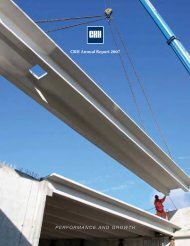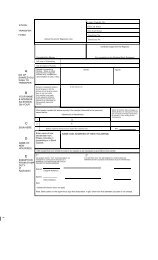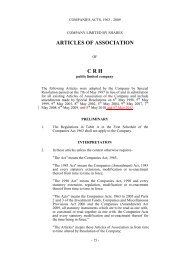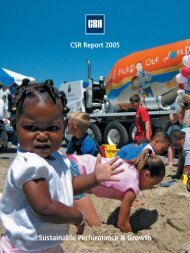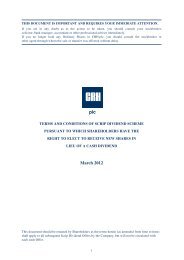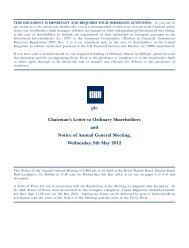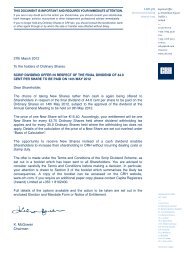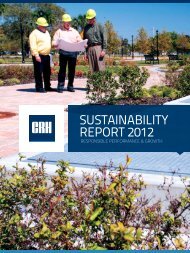2009 Annual Report - CRH
2009 Annual Report - CRH
2009 Annual Report - CRH
- TAGS
- annual
- www.crh.com
You also want an ePaper? Increase the reach of your titles
YUMPU automatically turns print PDFs into web optimized ePapers that Google loves.
operating adjustments were<br />
implemented including the temporary<br />
suspension of some business lines<br />
until such time as trading conditions<br />
improve.<br />
Overall operating profit declined<br />
compared with 2008.<br />
Switzerland<br />
GDP declined by 3.4% in <strong>2009</strong>,<br />
exports dropped by 12.5% but private<br />
consumption remained stable.<br />
Construction output rose by 3.3%,<br />
the highest growth since 2004.<br />
Civil engineering, supported by the<br />
national stimulus programme, grew<br />
by 8.8% and residential construction<br />
was up by 2.3%. Industrial<br />
construction activity declined.<br />
Lower fuel costs partly due to high<br />
usage of alternative fuels, together<br />
with increased volumes in our cement<br />
business and better margins in our<br />
downstream readymixed concrete<br />
and aggregates business, led to<br />
a profit outcome ahead of 2008.<br />
Market leadership<br />
positions<br />
Cement<br />
Top 10 Western Europe<br />
No.1 Finland, Ireland<br />
No.2 Portugal, Switzerland<br />
No.3 Poland, Ukraine, Tunisia (49%)*<br />
No.1 Aegean region, Turkey (50%)*<br />
No.1 Northeast China (26%)*<br />
No.2 Andhra Pradesh, India (50%)*<br />
Aggregates<br />
No.1 Finland, Ireland<br />
Asphalt<br />
No.1 Ireland<br />
Readymixed Concrete<br />
No.1 Finland, Ireland<br />
No.2 Portugal, Switzerland<br />
Agricultural & Chemical Lime<br />
No.1 Ireland<br />
No.2 Poland<br />
Concrete Products<br />
No.1 blocks and rooftiles, Ireland<br />
* <strong>CRH</strong> share<br />
Iberia<br />
Spanish construction activity<br />
continued its decline in <strong>2009</strong>, falling<br />
by about 20%. Residential and<br />
non-residential building fell steeply,<br />
only partly compensated by<br />
infrastructure spend, resulting in a<br />
lower profit outcome.<br />
The Portuguese economy declined by<br />
2.7% in <strong>2009</strong>; however construction<br />
fell by about 7% with the residential<br />
sector registering the largest decline.<br />
Our Secil joint venture, with three<br />
cement plants in Portugal, suffered<br />
from reduced domestic demand but<br />
increased its export volumes albeit at<br />
lower prices. While Secil enjoyed a<br />
good performance in its activities<br />
outside Portugal due to favourable<br />
demand and pricing coupled with<br />
lower fuel costs, operating profit<br />
overall was down on 2008.<br />
Eastern Mediterranean<br />
As expected, the Turkish economy<br />
and domestic Turkish construction<br />
activity continued to contract in <strong>2009</strong>.<br />
Strong export demand however<br />
helped selling prices in the Aegean<br />
region to stabilise in the second half of<br />
the year and the implementation of<br />
strong cost-control measures and<br />
improved operating efficiencies helped<br />
partly to offset the downturn in<br />
domestic demand. Overall operating<br />
profit was lower than 2008.<br />
China<br />
Our Chinese operations performed<br />
well in <strong>2009</strong> with cement volumes in<br />
northeast China increasing by 12%<br />
due to strong demand from<br />
infrastructure projects which were<br />
funded by the government stimulus<br />
programme. This increased demand<br />
created a favourable pricing<br />
environment that enabled our<br />
wholly-owned Sanling Cement to<br />
improve on prior year’s performance;<br />
our new associate Yatai Cement, in<br />
which <strong>CRH</strong> has a 26% share,<br />
exceeded expectations and reached<br />
record volumes.<br />
India<br />
My Home Industries Limited (MHIL),<br />
our 50% cement joint venture in the<br />
Andhra Pradesh region of southern<br />
India, had a strong performance in the<br />
first half of <strong>2009</strong> which benefited from<br />
strong government investment in<br />
housing and infrastructure. However,<br />
following the national elections,<br />
market conditions weakened in the<br />
second half with newly-commissioned<br />
cement capacity putting pressure on<br />
volumes and prices across our market.<br />
This resulted in operating profit for the<br />
year broadly in line with 2008. The<br />
new grinding plant near Vishakapatnam<br />
in eastern Andhra Pradesh was<br />
commissioned in August <strong>2009</strong>.<br />
Outlook<br />
Further declines in construction<br />
activity in Ireland are anticipated in<br />
2010. Lower consumer confidence,<br />
continuing restricted credit availability,<br />
unsold building stock and supply<br />
overcapacity will continue to put<br />
further pressure on volumes and<br />
margins.<br />
Polish GDP is forecast to grow by<br />
between 1.5% and 2% in 2010,<br />
however unemployment is expected<br />
to continue to increase. Inflation levels<br />
are expected to continue to decline<br />
and interest rates are likely to remain<br />
low. An increase in overall<br />
construction activity is expected,<br />
supported by a significant increase in<br />
infrastructure contracts awarded and<br />
a number of sports and stadium<br />
projects required for the European<br />
Football Championships in 2012.<br />
In Ukraine, construction activity is<br />
forecast to increase modestly in 2010<br />
resulting in improved volumes of<br />
cement. This together with continued<br />
focus on cost efficiencies should<br />
deliver improved margins.<br />
Construction demand in Finland is set<br />
to fall further by a mid single-digit<br />
percentage in 2010, with continued<br />
weak levels of activity in non-residential<br />
construction partially offset by<br />
improving residential construction and<br />
relatively stable infrastructure volumes.<br />
Switzerland is expected to stabilise at<br />
current levels. Both residential<br />
construction and infrastructure will<br />
continue to grow and are expected to<br />
compensate for a decline in<br />
non-residential activity.<br />
In Portugal, the outlook remains<br />
challenging with a further decline in<br />
residential activity likely to be offset by<br />
increased infrastructural activity. Cost<br />
efficiencies and improved use of<br />
alternative fuels should help maintain<br />
margins, but export markets are<br />
expected to be more challenging.<br />
Turkish GDP is forecast to grow by<br />
2.5% in 2010 and domestic<br />
construction activity is expected to<br />
increase at a similar rate. The positive<br />
trends experienced during the second<br />
half of <strong>2009</strong> are forecast to continue<br />
into 2010 although cement exports<br />
are likely to face stiff competition.<br />
Cement demand is expected to grow<br />
strongly in northeast China due to the<br />
continuing Government stimulus<br />
package and an improving residential<br />
market. We anticipate further margin<br />
improvement at our Sanling Cement<br />
business. The ongoing investment<br />
programme with Yatai Cement,<br />
together with a full year’s contribution<br />
from new acquisitions, will bring Yatai<br />
Cement’s total cement capacity to<br />
21 million tonnes.<br />
In India, we expect growth in demand<br />
in the Andhra Pradesh region to<br />
recover during 2010 and this should<br />
ease the pressure resulting from<br />
additional supply capacity. A full year<br />
contribution from MHIL’s new grinding<br />
plant is expected to add to sales<br />
growth and performance.<br />
Overall we anticipate more stable<br />
markets for Europe Materials’<br />
products in 2010 and we expect to<br />
benefit from lower energy prices and<br />
cost reductions in our operations.<br />
Industry capacity reductions and some<br />
increase in demand later in the year<br />
should be supportive to margins.<br />
However, the year has commenced<br />
with severe weather in many markets<br />
and the extent to which this will impact<br />
on demand and pricing levels for the<br />
year as a whole remains uncertain.<br />
<strong>CRH</strong> 23







